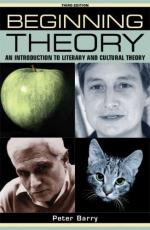
|
| Name: _________________________ | Period: ___________________ |
This test consists of 15 multiple choice questions and 5 short answer questions.
Multiple Choice Questions
1. What was the name of the Nigerian novelist who published his first novel, "Things Fall Apart," in 1958, and was criticized by an early reviewer for affecting identity with African villagers?
(a) William Faulkner.
(b) Chinua Achebe.
(c) J.R.R. Tolkien.
(d) Kurt Vonnegut.
2. W.B. Yeats was a member of the ________ ruling class in ________, according to the narrator in the chapter titled "Postcolonial Criticism."
(a) Aethist / America.
(b) Amish / Sweden.
(c) Protestant / Ireland.
(d) Jewish / Poland.
3. Who is credited with saying that the textuality of history is "an intensified willingness to read all of the textual traces of the past with the attention traditionally conferred only on literary texts"?
(a) Louis.
(b) Greenblatt.
(c) Dutton.
(d) Montrose.
4. What is the term used to describe the study of narrative structures that combines characteristics and is derived from structuralism and linguistic theory?
(a) Semiology.
(b) Scientology.
(c) Narratology.
(d) Ideology.
5. Ecocriticism was a term that was applied to the work previously known as what form of writing?
(a) Scientific.
(b) Nature.
(c) Nurture.
(d) Biological.
6. The panopticon was a design for a circular prison conceived by the eighteenth-century utilitarian ________.
(a) Anthony Burgess.
(b) Sigmund Freud.
(c) Ray Bradbury.
(d) Jeremy Bentham.
7. Peter Barry states that ________ is best understood by seeing it initially in the context of its own origins within feminism in the 1980s.
(a) Lesbian feminism.
(b) Beginning feminism.
(c) Radical feminism.
(d) Endangered feminism.
8. In the chapter titled "Narratology", ________ means slow telling where an author stages a tale for readers whereas ________ means relating where the narrator summarizes events without trying to create an illusion.
(a) Langue / parole.
(b) Metonymy / metaphor .
(c) Paradigm / paradigmatic.
(d) Mimesis / diegesis.
9. The narrator explains that conventional ________ is often seen by the stylistician as impressionistic, intuitive, and randomized.
(a) Constative language.
(b) Emotive language.
(c) Surface structure.
(d) Close reading.
10. Stylistics is the modern version of the ancient discipline known as ________, which taught its students how to structure an argument.
(a) Neoplatonism.
(b) Rhetoric.
(c) Neoclassicism.
(d) Philology.
11. In the following statement found in the chapter "New Historicism and Cultural Materialism," what does the word "panoptic" mean: "Michel Foucault's pervasive image of the state is that of 'panoptic'"?
(a) All-mighty.
(b) All-hearing.
(c) All-knowing.
(d) All-seeing.
12. ________ read major works from an ecocritic point of view and extend the application of concepts to areas other than the natural world.
(a) Ecocritics.
(b) Ecofeminists.
(c) Ecologists.
(d) Ecocentrists.
13. The ancestry of post-colonial criticism can be traced to Frantz Fanon's ________, published in French in 1961, and voicing what might be called "cultural resistance" to France's African empire.
(a) The Grapes of Wrath.
(b) An American Tragedy.
(c) The Wreched of the Earth.
(d) U.S.A. (trilogy).
14. Who argued the fluidity of identity, including sexual identity in their highly influential "Epistemology of the Closet"?
(a) Judith Butler.
(b) Rock Meyer.
(c) Eve Sedgwick.
(d) Diana Fuss.
15. According to Peter Barry at the beginning of the book "Beginning Theory," many of the chapters in the book were based on material Barry has used in the "Introduction to Literature" courses at what university?
(a) LSU.
(b) TSU.
(c) ASU.
(d) FSU.
Short Answer Questions
1. The narrator details that ________ believed that some speech was reported while other speech was mimetic, transposed, or narratized.
2. According to Peter Barry, what is the subject of narratology common to all story-telling?
3. The narrator explains that narratology studies how narratives, or stories, creates ________.
4. The chapter "New Historicism and Cultural Materialism" explains that the practice of giving ________ to literary and non-literary material is the first and major difference between the "new" and the "old" historicism.
5. The gist of "Style in Language," edited by ________, is to claim that linguistics offers a more objective way of studying literature, and the book tends to set up "a confrontation of camps" between literary and language studies.
|
This section contains 603 words (approx. 3 pages at 300 words per page) |

|




